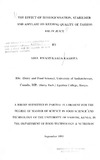| dc.description.abstract | In this study, the effects of homogenisation, stabiliser
and amylase individually and in two factor combination,on
the keeping quality of passion fruit juice were
investigated. The juice was extracted from the two mixed
types of Passiflora edulis passion fruits, sweetened,
preserved with sodium metabisulphate and sodium benzoate,
heated to 75°C for 15 minutes and then treated by
homogenisation, stabiliser and amylase. The changes, in
titratable acidity, pH, clarification/gelation, cloudiness
(absorbance at 660nm), visible browning (absorbance at
20nm) viscosity flow time and concentration of total
soluble solids during storage at room temperature were
determined on weekly basis. Sensory qualities [colour,
appearance, flavour and texture (mouth feel)] of the juice
samples were also determined at the beginning and at the
end of storage period on a 7-point hedonic scale.
There was no clarification in all sample treatments and the
untreated sample.
Homogenisation (Treatment A) did not affect total
titratable acidity and pH but decreased cloudiness and
visible browning. Homogenisation before and after
pasteurisation increased and decreased viscosity
respectively. It also increased concentration of soluble
materials in the juice. During storage of homogenised
juice, there was no change in total titratable acidity, pH
and concentration of total soluble solids but cloudness and
visible browning increased whereas viscosity decreased.
Stabiliser content (Treatment B) had no effect on total
titratable acidity, pH, and concentration of total soluble
solids. It increased cloudiness, visible browning and
viscosity. There was no change in total titratable acidity,
pH, viscosity and concentration of total soluble solids but
the cloudiness and visible browning increased during
storage.
Amylase action time (Treatment C) increased total titrable
acidity, cloudiness and concentration of total soluble
solids. It decreased pH, visible browning and viscosity.
There was no change in pH, visible browning, concentration
of visible materials, cloudness and viscosity during
storage.
Homogenisation + stabiliser combination (Treatment D)
decreased total titratable acidity, and increased
cloudness, visible browning and viscosity. This combination
had no effect on pH and concentration of total soluble
solids.
XXlll
During storage of the juice which was treated with this
combination, there was no change in total titratable
acidity, pH and concentration of total soluble solids but
there was an increase in cloudness, visible browning and
viscosity during storage.
Homogenisation + amylase combination (Treatment E) had no
effect on total titratable acidity and pH. It decreased
cloudness, visible browning and viscosity but increased
concentration of total soluble solids. The total titratable
acidity, cloudness and viscosity increased but there was
no change an pH, visible browning and concentration of
total soluble solids during storage.
Stabiliser + amylase combination (Treatment F) had no
effect on total titratable acidity and pH but increased
cloudiness visible browning, viscosity and concentration of
total soluble solids. There was a decrease in cloudness
and an increase in viscosity during storage.
The sensory quality scores for colour, appearance, flavour
and texture of the juice indicated that among individual
factor treatments, the order of preference was homogenised
juice, juice with stabiliser and juice treated with amylase
irrespective of the storage period.
xxiv
The order of preference for colour, appearance, flavour and
texture in the three combinations was no the same, but the
order of preference remained the same for each sensory
quality attribute throughout storage time. The colour of
the juice which was treated with homogenisation +
stabiliser was most preferred and was followed in the order
homogenisation + amylase and stabiliser + amylase
combination. The appearance of the juices treated with each
of the three combinations was almost the same.
Homogenisation + stabiliser combination had the highest
scores for flavour and was followed in the order of
stabiliser + amylase and homogenisation + amylase. The
texture of the juice which was treated with homogenisation
+ amylase combination was inferior to that of the juice
which was treated with the other two combinations.
Among individual factor treatments homogenisation at 3000
psi produced the best juice and among two factor
combination treatments 3000 psi + 0.2% stab. treatment
produced the best juice, based on the effect on the
parameters measured and sensory scores. In both
treatments, it is recommend to treat the juice before
pasteurisation. | en |

